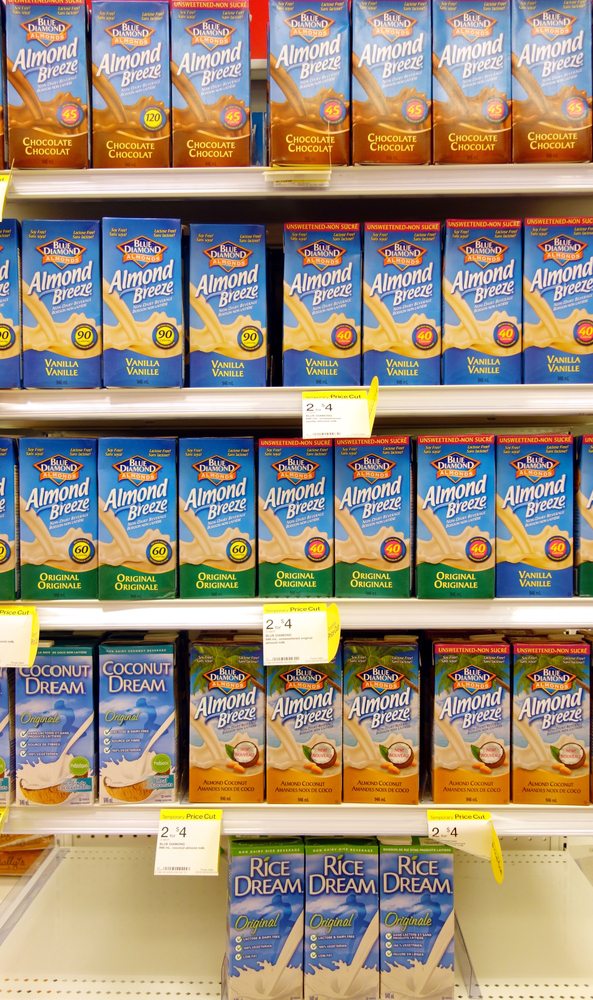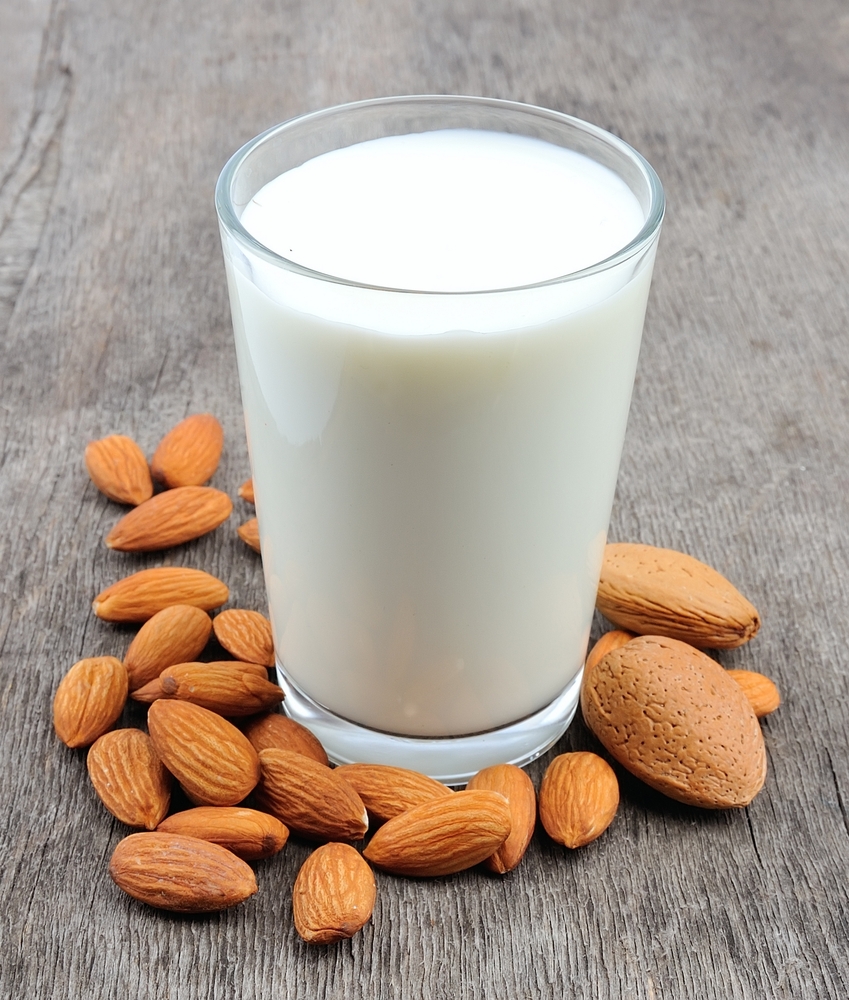To start off the week, today’s post is something I’ve gotten many questions about, and am excited to finally address it!
Have you ever picked up a carton of almond milk or coconut milk to check the ingredients list and wondered what one (maybe even more than one, depending on the brand) of them actually was?
If there was only one questionable ingredient that made you stop and wonder, it was probably carrageenan, which is added to a surprising number of foods (for humans and their pets) and drinks- yet doesn’t really add any nutritional value.
Carrageenan has been met with quite a bit of criticism, most notably from those like Dr. Andrew Weil. And it’s been purportedly linked with some pretty hefty health issues, even though it’s not a new ingredient at all. Still, there are differing opinions regarding its safety.
Is it as bad as some experts say? Or is it safe, like the FDA claims (the FDA lists it as “Generally Regarded as Safe,” or GRAS)?
What Is Carrageenan?

Before we get into the possible dangers (or not) of carrageenan, let’s talk about what carrageenan actually is. The name alone sounds a little clinical and scary, right?
It is a food additive that’s even allowed in organic foods, and it comes from seaweed–red seaweed to be exact, which some say causes inflammation in the body.
Carrageenan has been used in different foods and drinks since the 1930s, so it’s not exactly some new ingredient that’s just been created and started being haphazardly sprinkled into processed foods. However, the debate around it has just started heating up even though experts have been conducting research on it for decades.
Some of the results of those studies didn’t put carrageenan in a flattering light. Yet in May 2012, the National Organic Standards Board chose to allow carrageenan in organic foods for another five years.
Why Companies Use Carrageenan In Certain Products
It’s used as an emulsifier and thickener in things like:
- Non-dairy milks (almond, coconut, hemp, soy, etc) as well as some cow’s milk
- Ice cream (dairy and non-dairy versions)
- Frozen dinners
- Frozen pizzas
- Canned goods (like soups)
- Sour cream
- Pre-made “nutritional” drinks often used as meal replacements
- Cottage cheese
Basically, it’s added so you don’t have to shake or stir things up before you eat or drink them, or so the texture feels creamier and fattier (maybe more satisfying?), than it would otherwise.
Degraded vs. Undegraded Carrageenan
No matter what as far as its safety is concerned, I don’t believe carrageenan is a necessary—or beneficial—additive, really (other thickeners that act in a similar way and aren’t surrounded by such controversy include guar gum and locust bean gum).
However, I also think a lot to the fear over it has been taken a bit too far. There’s a lot of confusion around this ingredient and whether it’s worth replacing with other things because there are two different types of carrageenan—one is generally deemed safe for human consumption by the FDA and the other is not.
- Undegraded carrageenan is deemed okay by the FDA to be used in foods.
- Degraded carrageenan, also called poligeenan, is not.
Is Food-Grade Carrageenan Actually Safe to Consume?
One study points out that undegraded carrageenan could be linked to ulcers and tumors of the colon right along with the degraded carrageenan, for these possible reasons:
- Contamination from the degraded carrageenan
- The breaking down of the undegraded carrageenan into degraded carrageenan when exposed to stomach acid
- Exposure to intestinal bacteria
An entry in Critical Reviews in Toxicology , on the other hand, states that food grade carrageenan maintains its higher molecular weight, is not broken down to become harmful like poligeenan, and is not absorbed by the body. The review looked at studies concerning rodents, dogs, and non-human primates.
The review states there’s no need to worry that the carrageenan used in food is toxic or carcinogenic.
So what’s the difference, if they’re both carrageenan and derived from the same seaweed?
One is more processed. Carageenan has a higher molecular weight than poligeenan. Poligeenan is derived from carrageenan when it’s processed at a high temperature with strong acids for six hours or more. It’s broken down into shorter chains and a lower molecular weight during this process.
That lower weight could allow it to be more readily absorbed into the blood stream, which is when it really gets potentially harmful and could contribute to health problems. Otherwise, the idea is that carrageenan, because of its higher molecular weight and inability to cross into the blood stream, just goes right through the body without causing any trouble.
The undegraded carrageenan with the higher molecular weight is supposedly safe for human consumption, but the jury is still out.
There are too many unknowns about what happens when it’s broken down by the human body, despite animal studies that say carrageenan is safe (remember, there are also studies that say otherwise).
It may be safe, but I’m still a little skeptical and would suggest largely avoiding it.
What Are the Health Concerns Linked to Carrageenan Consumption?
Though most of the proven health issues with carrageenan are attached to degraded carrageenan (poligeenan) which are not allowed in food products, further studies have shown that undegraded carrageenan could be unhealthy as well.
Some of the top concerns linked to carrageenan in animal studies include:
- Bloating and bowel trouble, like IBS or IBD
- Inflammation (which is at the root of lots of health conditions and could lead to arthritis, heart disease, cancer, Alzheimer’s, and a number of others, as well as various aspects of speeding the aging process)
- Autoimmune response
- Cancer, especially of the colon (poligeenan is a carcinogen and there’s a debate about whether undegraded carrageenan becomes one during digestion, too, but I’ll talk more about that in a minute)
- Ulcerative colitis
- Glucose intolerance
There’s So Much Conflicting Information…Is It Really That Bad?
Maybe, maybe not.
In a lot of the tests that have been conducted over the years with a variety of outcomes, the carrageenan was usually fed in much higher amounts than any human on a whole foods based diet would consume on a regular basis. You probably aren’t consuming that much of it if you’re focusing on fresh produce and avoiding the processed—even processed organic—stuff.
Carrageenan was also not fed to the animals as part of another food; instead, the doses were given in water.
Could the amount or delivery method be an issue?
Possibly. Without further testing, we can’t know for sure.
There were also different reactions depending on the type of animals used in the studies; sometimes different species in the same study would experience different outcomes. For example, in one report that looked at carrageenan’s effects as far back as the 1960s, there are a few studies that analyzed degraded and undegraded carrageenan’s effects. Several studies were discussed, but here’s an overview:
- Guinea pigs fed undegraded carrageenan developed ulcerative colitis.
- In one study where rats, rabbits, guinea pigs, squirrel monkeys, hamsters, and ferrets were fed undegraded and degraded carrageenan the guinea pigs and rabbits showed ulcerations in their large intestines, but other species did not.
- All rats given either type of carrageenan experienced gastrointestinal inflammation, but the ones fed degraded carrageenan also had a higher risk of developing tumors.
- Rats’ intestinal cell membranes appeared compromised when they consumed either kind of carrageenan.
The report also points out scientists’ concern about food-grade carrageenan—and subsequent letters to medical journal The Lancet—as early as the 1980s.
In a separate comparison between degraded and undegraded carrageenan on rhesus monkeys, the ones that received undegraded (food grade) carrageenan gained weight normally and didn’t seem to suffer any adverse effects. The ones fed the degraded carrageenan, however, lost weight, lost blood through their intestinal tracts, and some developed anemia.
Dr. Joanne Tobacman
Finally, one researcher who is well-known for her studies in carrageenan, Dr. Joanne Tobacman, now an associate professor of clinical medicine at the University of Illinois College of Medicine, has been investigating the issues with undegraded carrageenan for decades and has completed 18 peer-reviewed studies on the topic. Her findings suggest that both types should be banned and she wrote to the National Organic Standards Board about it in 2012 to no avail.
She argued that both types of carrageenan can cause inflammation and that humans do get enough in their diet to suffer because of its addition to common foods and beverages. The American average is 250 mg per day (think of all the processed foods in the Standard American Diet!); the rats in her studies received the equivalent of 100 mg (when adjusted for weight and size) and developed tumors. Because either type can cause inflammation, she argues that either type can cause a laundry list of diseases.
After all, what’s at the root of so many modern diseases? Inflammation.
Not many tests have been done involving humans, but Dr. Tobacman has been able to test carrageenan’s effects on human cells. The breast cells actually died.
Though there’s no set “safe” or “unsafe” decision across the board because several of the tests and studies yield different results, there’s still enough evidence pointing toward the “unsafe” camp to make me want to avoid carrageenan whenever possible, despite what the FDA says or what the molecular weight of carrageenan versus poligeenan is.
If there are no obvious benefits, why routinely introduce it to your body?
If you’re following the Beauty Detox principles, you’re probably naturally pretty safe from carrageenan anyway. You’re not consuming dairy in any form, so the yogurt, ice cream, cottage cheese, and sour cream aren’t part of your life anymore. You’re probably almost never consuming those processed foods, like the breakfast shakes and frozen dinners and pizzas, either.
There’s one place you may still be getting carrageenan exposure, though…
Your cow’s milk substitute.
Despite small amounts of carrageenan in certain brands of almond, hemp, or coconut milk–I’m not convinced you need to cut them out of your diet completely until we have more conclusive evidence. Those drinks make fantastic treats (almost-raw vegan hot chocolate, anyone?) and smoothie bases, and I still use those products on occasion, especially if I’m traveling.
Still, if you’re intent on avoiding it, you check the list below to see if you can find any of the carrageenan-free products near you. If those aren’t available, don’t worry! Because—guess what—making your own almond milk is super easy! It just takes a little forethought because you have to remember to soak your almonds first. We only use raw almond milk at Glow Bio from organic, soaked and rinsed almonds! :)
Personally, I think it tastes much better when you make it fresh, anyway, and you can control the amount of vanilla you add and control the sweetness by adding more dates or stevia. You can switch it up and use hazelnuts, too. How good does hazelnut hot chocolate sound right now?
Products That Are Free of Carrageenan
Okay, so maybe adding “Make almond milk” to your to-do list is the last thing you want to do right now. I totally understand not wanting to add one more thing to your list of things you need to do to (I know, there’s probably a lot on there already!), and sometimes you just want something convenient.
If you want to avoid carrageenan at all costs, even in the small amounts that may be in the occasional almond milk you consume, luckily there are some brands out there that do not use carrageenan in their products. You’ll have to be a little picky and you may have to go a little out of your way to find the right brands, but avoiding carrageenan can be done.
Try these brands for carrageenan-free milk substitutes:
- 365 Whole Foods
- Trader Joe’s (the one in the refrigerated section)
- Silk Pure Almond (their coconut milks do contain carrageenan)
- Kroger’s Simple Truth brand
- Tree of Life
Things change and ingredients come and go (often based on what the customers ask for!), so be sure to read the label before you buy your milk. And just because something isn’t on this list, that doesn’t mean that a brand won’t remove carrageenan in the future.
Keep checking the labels if there are no carrageenan-free options where you live right now. You could also try talking to the management at the grocery store to see if they’d be willing to branch out and introduce another brand—but go armed with your information so they know which ones you’d love for them to start carrying.
So Should You Worry?
Because it’s an unknown and there are options without carrageenan, I would say steer clear when you can. However, if you don’t have a choice and have to have a small amount of almond milk that lists carrageenan as an ingredient every now and then, don’t stress out about it too much. It’s a tiny amount and you’re probably not getting much exposure from other sources if you’re eating a healthy, whole foods in a non-processed diet without dairy.
Also, if you’re in a situation where you have to make a choice between carrageenan-free milk from a cow and a milk alternative that contains carrageenan, never go for the dairy! The same is true of other things, like soda or other foods and beverages with wheat, high-fructose corn syrup, high sodium levels—you get the idea. It may not be good for you, but carrageenan is the lesser of those evils.
What’s the Final Verdict When It Comes to Carrageenan?
The answer is, we have no final verdict. This post is unique in there there is no clear black or white… not yet at least. There is evidence that carrageenan may be bad for you, and yet as we discussed, it may also be that the form and amount used in products like almond milk isn’t really harmful.
The purpose of this post is to explore the topic thoroughly, present you with both perspectives, and give you the information to make your own decision.
And now that you’ve read this, I’m curious, were you already trying to eliminate carrageenan from your diet? Do you plan to do so now?
If you decide to make your own almond or hazelnut milk, let me know!
I want to know how it turns out and how you customize it for your own tastes. Also, if you’ve found another carrageenan-free brand that isn’t on the list, share it in the comments section.
I hope this post is helpful. Keep in mind that many health topics are like this–there’s a grey area that need to be explored, researched and thought through.Sometimes the best thing we can do is research, discuss and then each make our own individual decisions accordingly.
Thank you so much, and I look forward to hearing from you below! Have a beautiful day, and take care of yourself.
In Love and Health,
Kimberly






YAY thank you SO much for posting this incredibly thorough & informative report on carrageenan. I’ve been wondering about it since I first started hearing bad things about it a couple weeks ago, and it’s super helpful to hear your take on it. I take your word as gospel and appreciate your breaking the whole thing down, including names of brands that don’t use it in almond milk. I tried making my own almond milk as soon as I heard about carrageenan, but I think I’m gonna end up buying it premade at Whole Foods or Trader Joe’s from now on – I’m too busy to do it more than once a month! Thanks again for this really helpful post.
I have been avoiding carrageenan for over 10 years now, because of its MSG content. (Not consuming MSG, in all its hidden forms, has been the best thing I’ve done to help control my severe migraines.) My favorite brand of almond milk (Original flavor) is Coburn Farms, from Sav-A-Lot food stores. It tastes so incredibly good, and contains no carrageenan.
So I just noticed there is Carageenan in my Toms toothpaste…. does anyone have anything to say about this? should I be ok because I’m not really ingesting it? This stuff is everywhere!
Thank you for sharing this article with us. Since discovering your blog and reading both books I have completely given up dairy and drastically changed my diet for the better. I always thought I ate healthy, but you shed light on the false information and dietary myths most of us have been made to believe our whole lives. (Before reading your books my doctor was telling me I needed MORE dairy for calcium in my diet!) At 24 years old I was feeling sick and lethargic, and after transitioning my diet I
Thank you for sharing this article with us. Since discovering your blog and reading both books I have completely given up dairy and drastically changed my diet for the better. I always thought I ate healthy, but you shed light on the false information and dietary myths most of us have been made to believe our whole lives. (Before reading your books my doctor was telling me I needed MORE dairy for calcium in my diet!) At 24 years old I was feeling sick and lethargic all the time. 2 years later and 20 lbs lighter after transitioning my diet I feel amazing!
I currently use Trader Joes almond milk that does not contain Carrageenan for most of my dairy substitutions, however in coffee (my occasional vice I still haven’t completely eliminated) I prefer coconut milk – I will now be looking for a brand w/out Carrageenan!!
There are benefits to using carrageenan. Two examples are that it aids in both fat and sodium reduction.
Regarding the safety of carrageenan, there has been an amazing amount of misinformation being blogged about carrageenan being unsafe as a food ingredient. In spite of this misinformation, carrageenan continues as the safe food ingredient it has always been. If it were not, the principal regulatory agencies of the world (US FDA, FAO/WHO JECFA, EU EFSA, and Japan Ministry of Health) would not approve its use, and all of them give the necessary approvals. The only application restricted as a precautionary measure is stabilizing liquid infant formula and a definitive toxicology is about to be published that is expected to remove this restriction.
Why all the concern about the safety of using carrageenan in foods? Starting in the 1960s there have been research studies showing that if excessive doses of carrageenan are consumed in animal trials inflammation can be induced in the small intestine. Likewise, inappropriate methods of introducing the carrageenan into the animals, i.e. in the animals’ only source of drinking water, have induced an inflammatory response in the small intestine. However, there has never been a validated inflammatory response in humans over the seventy plus years carrageenan has been used in foods. The anecdotal “upset tummies” reported in blogs as coming from consuming a food containing carrageenan are hardly
reliable sources of information on the safety of carrageenan.
Inflammatory responses in animals only occur when carrageenan can cross the blood membrane barrier of the small intestine. This only occurs when the extreme feeding conditions mentioned above are employed. Normal feeding regimes induce no such response.
Over the last decade a group of molecular biologists at the University of Illinois at Chicago lead by Dr Joanne Tobacman have been exploring the in vitro interaction of carrageenan with various genes and conclude that carrageenan can cause inflammation in the gut via a binding mechanism involving TLR-4 receptors. This group also concluded that carrageenan degrades in the gut and the degraded carrageenan can permeate the membrane barrier. Recent studies refute both of these claims, and furthermore this recent research questions the validity using in vitro studies to mimic the in vivo events in the GI tract when a human consumes a food containing carrageenan.
The bottom line on the safety issue is that in spite of all the efforts to downgrade or question the safety of carrageenan, particularly by bloggers, carrageenan is a safe food ingredient in all of the major regulatory jurisdictions of the world.
Hi ,
My name is Sherry and I just started reading your book “Beauty Detox” . I am so excited and I have never felt more convicted to do something about my current lifestyle, eating habits and overall health. I am 6 months away from turning 45 (prayerfully ) with a 5 &9 year old. The major concern is I have ulcerative colitis and I was diagnosed in 2006. I have experienced several flares over the years and the treatment is always steroids, I now have secondary high blood pressure and of course I am overweight. I am wondering how I can begin this process of detox when my colon is already a mess?? Is this going to send me into a flare with all of the fruits and vegetables? ?
Please help me. I am so tired of taking meds I don’t know what to do. I take the meds and still have flares, what’s the point, I am always bloated I have learned to accept it.
Sincerely,
Sherry
” Terribly Confused “